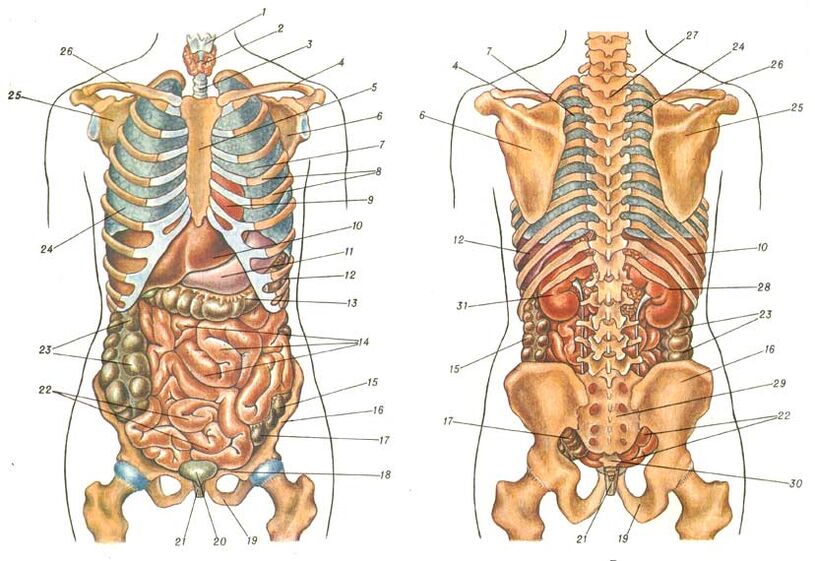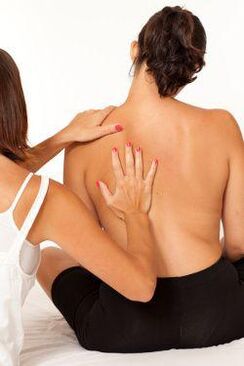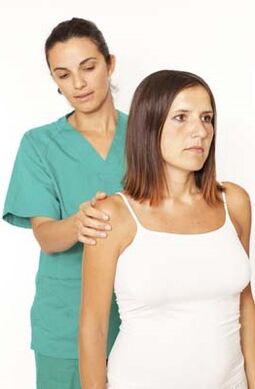Sometimes we have discomfort in the back on the left side. There can be pain of different types - pulling, stabbing, aching. They may be accompanied by additional symptoms. Pain under the left shoulder blade is usually not the only symptom. This is one of the signs of the manifestation of any disease. All complaints and symptoms together will help the doctor choose the direction of the diagnosis. After all, immediate help is often required.
The anatomical structure of the body
If we look at our body from behind, we see that the left shoulder blade is located on the ribs involved in the formation of the chest. Nerves and blood vessels run between the ribs. They are connected by muscle fibers.
The scapula performs a protective function of the internal organs - heart, lungs, stomach and pancreas, spleen.
Based on the anatomical structure of the body, pain under the left shoulder blade can be conditionally divided into:
- in connection with the pathology of the musculoskeletal system,
- associated with the pathology of an internal organ.

Why are there complaints on the left
Many of us, when left-sided pain appears, first consider problems in the work of the heart. In fact, the cause is more often a problem in the spine. Internal organ dysfunction can also occur.
Let's consider in more detail the causes of pain under the left shoulder blade. They can occur when:
- Problems with the spine and musculoskeletal system: osteochondrosis, intercostal neuralgia, shoulder blade injuries, broken ribs, myofascial syndrome, Sprengel's disease.
- Diseases of the bronchi and lungs: pneumonia, localized on the left, dry pleurisy, bronchitis in the acute course, tracheitis, left-sided lung abscess.
- Diseases of the cardiological system: angina pectoris, coronary artery disease, myocardial infarction, valve prolapse.
- Gastrointestinal disorders: gastric and duodenal ulcers, gastroesophagitis, reflux, esophageal spasm.
- Psychosomatic course of the disease with vegetative-vascular dystonia.
Relationship between pain and illness
Patients can characterize the nature of the pain from aching to cutting and burning. There are several typical signs of pain that distinguish it from other diseases:
| disease name | pain that characterizes him |
|---|---|
| heart diseases | Pain in the area of the left shoulder blade is burning in nature, causing a feeling of compression of the retrosternal space. It occurs in the same place, moving to the left side - back, shoulder blade, arm. When pressing, as if squeezing heart pain, the spread of myocardial infarction is possible. In this case, urgent hospitalization is required. |
| aortic aneurysm | The pain is sharp, shooting, growing, goes to the left in the back and under the shoulder blade. The condition develops rapidly and threatens the patient's life. |
| pleurisy | The pain is sharp and stabbing, depending on the size of the breath. In a calm state, tingling is possible, when inhaling with a full chest, stabbing pains appear in the shoulder blade. |
| Left-sided pneumonia | The pain is not strong, aching, can be characterized as a point. May increase slightly with exercise and deep inspiration. |
| Osteochondrosis of the vertebrae | Most often the pain is localized at the bottom of the neck. It is manifested by painful sensations, which are aggravated by a sharp movement of the head. It can give into the hand, accompanied by turning of the head, numbness of the limbs. The pain under the shoulder blade is weak, aching and pulling, with a long sitting position or after physical exertion, the pain may increase. This usually happens in the evening. In the morning, a stiffness of the spinal muscles is felt. Unlike heart pain, it does not go away after taking medication. Severe headaches that are not related to pressure may occur. |
| Diseases of the gastrointestinal tract, ulcers in the stomach and intestines | Pain in diseases of the gastrointestinal tract can occur seasonally with attacks. Pain syndrome can occur at night due to prolonged hunger immediately after eating, a couple of hours after eating. The pain disappears after hunger quenching, after food leaves the stomach, after vomiting or taking medication. If the ulcer is perforated, the pain radiates under the left shoulder blade, it is acute and unbearable. If you suspect this disease, you should immediately go to the hospital. At the beginning of the development of the disease, the pain after vomiting may subside. Accompanying symptoms of reflux oesophagitis are heartburn, belching and indigestion. |
| intercostal neuralgia | A sharp prick or belt pain is felt constantly or in attacks. Can occur unilaterally. Increases with sudden movements - sneezing, coughing, severe shortness of breath, walking, physical activity, palpation of the pain site. |
| Vegetative-vascular dystonia and myofascial syndrome | In myofascial syndrome, the pain is dull and comes from deep within the tissues. It can occur both at rest and during physical activity. Intensity can range from easy to difficult. Objectively, during the examination, patients with VVD suffer from irritability, memory impairment, sweating, tachycardia, and tremors of the hands. Often there are changes in the heart muscle. The nature of the pain is similar to that of the heart. But examination of the heart does not confirm the diagnosis. |
Diagnosis of the disease that caused the pain syndrome

A close examination is needed to find out what is causing the pain. First of all, you need to consult a therapist or doctor. He determines what kind of research needs to be done based on the patient's complaints and examination.
If the pain radiates to the left shoulder blade, the first stage of treatment should be a visit to the local therapist. He can carry out an initial examination and order all necessary examinations. And even with the existing examinations, you can get advice from narrow specialists.
The doctor will not be able to diagnose the disease solely on the basis of the complaints of the pain syndrome. Complaints will be an impetus in the direction where a more thorough diagnosis is needed. Therefore, when contacting a doctor, it is necessary to know exactly the answers to questions about the nature of the pain, its localization and the concomitant causes - the connection with food intake, physical and emotional stress.
If myositis is suspected in a patient, it is necessary to conduct a detailed blood test to confirm the inflammatory process.
In order to more accurately diagnose the disease, it is necessary to conduct a number of examinations.
The first task is to rule out conditions that require emergency medical care. These include: gastric and duodenal ulcers, myocardial infarction, aortic rupture.
To understand exactly what hurts under the left shoulder blade, you need to undergo the following examinations:
- Visual inspection and palpation of pain location. Temperature, blood pressure and pulse are measured.
- X-ray in multiple projections to confirm or deny problems with the spine and lungs.
- ECG to check the heart's work.
- To clarify the location of the problem with the spine, a CT scan or MRI may be required.
- If gastrointestinal problems are suspected, FGS may be prescribed - fibrogastroduodenoscopy.
- General and biochemical blood tests.
For some types of pain, first aid can be provided with analgesics and antispasmodics. But their reception does not eliminate the cause, but only drowns out the pain from the left under the shoulder blade, which will definitely return after the end of the drug. In order to prevent the recurrence of pain, it is necessary to find out the cause.
If the left shoulder blade hurts, then in any case, after stopping the first signs of pain, it is necessary to undergo a full examination. Finally, the source of pain radiating into the shoulder blade can often be localized elsewhere. Therefore, if there is a pain syndrome in the area of \u200b\u200bthe scapula, it is necessary to see a therapist, a neurologist, a cardiologist, a gastroenterologist, a traumatologist, except for the pathology of all the listed specialists , consultation with a psychotherapist is necessary.
Treatment of the disease that caused the pain syndrome

The purpose of treatment depends on the diagnosis of the disease. Each specific disease has specific treatment regimens. They necessarily contain recommendations on physical activity and nutrition. The medication regimen is described in detail. They are combined according to the symptoms and conditions to relieve life-threatening acute symptoms.
In any case, you need to remember that pain in the left shoulder blade can only be eliminated with medication recommended by a specialist. Do not resort to the advice of relatives and friends. After all, without medical help, it is difficult to determine the nature of the pain. Self-medication can delay heart or stomach diseases.
- For example, for reflux, medication may be prescribed after the exam to reduce the acidity of the stomach and facilitate its movement in the intestine. In this case, it is worth limiting the amount of food eaten, you should not bend down immediately after eating.
- With osteochondrosis, physiotherapeutic exercises, swimming, dry heat and an increase in physical activity can be prescribed as medical procedures. All of these measures serve as prophylaxis once the pain has subsided.
- If ischemia is diagnosed, heart medication should be taken first. If after 10 minutes the pain in the left shoulder blade does not go away, you need to call an ambulance.
- In the case of problems with the cardiovascular system, the best prevention is constant intake of the necessary medication, diet, mental stability and not excessive physical activity.
- If pain in the shoulder blade occurs due to problems with the spine, it is necessary to perform a set of special exercises for a long time and follow the recommendations of specialists when taking medication.
- If the appearance of pain under the left shoulder blade is accompanied by gastrointestinal problems, then diet and medication will help to cope. In this case, psycho-emotional balance is important, since stress often causes an ulcer. A positive attitude and mastery of relaxation and relaxation technique are required.
If conservative treatment does not show a result, as well as when a perforated ulcer, a large hernia of the spine, a rupture of the spleen is detected, surgical intervention is required.
Basically, to avoid serious health problems, an annual medical check-up is required. It is necessary to undergo the necessary examinations in order to exclude the occurrence of diseases in the near future.















































